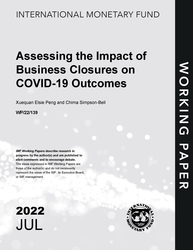
Assessing the Impact of Business Closures on COVID-19 Outcomes
Assessing the Impact of Business Closures on COVID-19 Outcomes
READ MORE...
Volume/Issue:
Volume 2022
Issue 139
Publication date: July 2022
ISBN: 9798400213472
$20.00
Add to Cart by clicking price of the language and format you'd like to purchase
Available Languages and Formats
| English |
Prices in red indicate formats that are not yet available but are forthcoming.
Topics covered in this book
This title contains information about the following subjects.
Click on a subject if you would like to see other titles with the same subjects.
Economics- Macroeconomics , Economics / General , Health Policy , Demography , business closure policy , industry contribution , Policy impact summary , industry closure , Policy timeline , IMF working papers , data construction , COVID-19 , Consumption , Capacity utilization , North America , closure policy , destination industry , lockdown policy , cases data , Health care
Summary
In this paper, we present a framework for assessing the effectiveness of different business closure policies, using New York City as a case study. Business closure policies have been widely implemented in an attempt to slow down the pandemic, but it is difficult to measure the contribution of closures of specific industries to virus transmission. Our framework allows us to estimate the impact of specific industry closures on the spread of COVID-19 via their effects on aggregate mobility. We find that early reopening led to a prolonged pandemic and a large case surge in the second wave during 2020, though the reopening allowed the city to regain its economic function as a consumption hub. An alternative policy that extends the lockdown is found to be more cost-effective as it makes future traveling safer and prevents the economy from relapsing into a more stringent policy regime.



